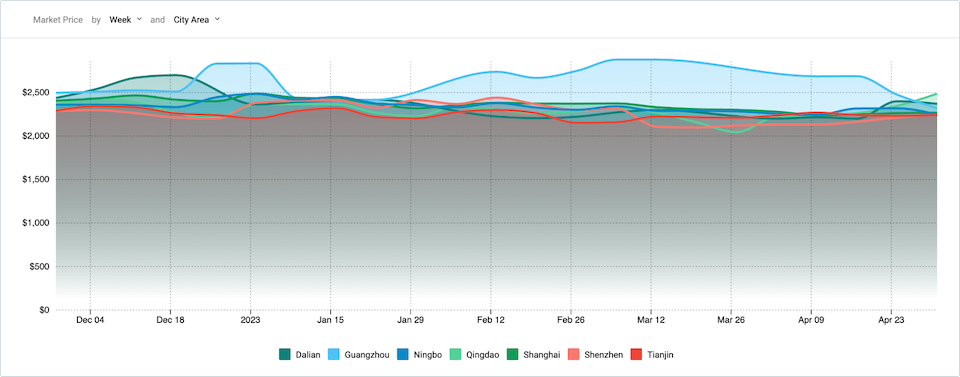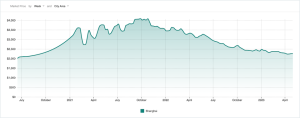Despite facing challenges in global markets, China's exports experienced a remarkable rebound in the first quarter of 2023. After a period of decline, China's exports in March rose by an impressive 14.8% compared to the previous year, marking a positive turn of events according to the May Asia container market forecaster published by Container xChange, an online container logistics company that provides a marketplace, an operating infrastructure, and a layer of services like payments to container logistics companies globally.
The General Administration of Customs of China reported that exports for the first three months of the year reached $821.8 billion, representing a 0.5% increase over the same period in 2022. Interestingly, despite the increase in trade, shipping companies are still facing the issue of empty containers piling up at Chinese ports. This situation is puzzling given the overall growth in exports. The explanation lies in the nature of the exported goods.

Resilient China Exports Fueled by High Factory Capacity and Demand for Specialized Cargo
This rebound in China's exports can be attributed to factories operating at full capacity to fulfill accumulated orders. Following China's COVID-19 outbreak, inventories were depleted, but now the country's international trade is displaying resilience. The Shanghai Containerized Freight Index also rose for three consecutive weeks in April, a trend unseen since June 2022.
Further, there has been a strong demand for new/alternative energy vehicles, lithium batteries, and solar cells, which are often transported via specialized vessels known as roll-on/roll-off (roro) carriers rather than standard containers. Additionally, bulk cargo such as steel and refined oil is typically transported using dry bulk carriers and tankers, eliminating the need for containerized shipment.
Challenges Persist for China's Shipping Industry Despite Resilient International Trade Growth
“Despite these positive indicators, there are still challenges in the shipping industry. The volatility in container prices has significantly reduced globally, suggesting stabilization in the market. However, many empty containers are accumulating at Chinese ports, pointing to underlying issues and weaker demand.” said Christian Roeloffs, cofounder and CEO, of Container xChange.
“The exact reasons behind this phenomenon are complex and involve various factors, including the mismatch between the types of goods exported and container shipping methods used. This paradox highlights the complex challenges faced by the shipping industry and the resilience of China's international trade.”, he added.
The ongoing accumulation of empty containers at Chinese ports has been a cause for concern among industry players. Furthermore, the drop in e-commerce globally has also impacted the shipping industry adversely. Although China's exports have rebounded, the growth in global e-commerce has slowed in recent years. According to Insider Intelligence, the growth rate of global e-commerce has steadily declined from above 20% in 2015 to 7.1% in 2022. The forecast for 2023 indicates a slight increase to 8.9%, suggesting a more cautious growth trajectory. These trends in e-commerce contribute to the challenges faced by shipping companies.
While shipping companies operating ro-ro vessels experience growth and profitable freight rates, most shipping companies continue to suffer from weak demand. This situation underscores the challenges faced by the industry, and freight rates serve as reliable indicators of market conditions. The increase in shipping rates from Asia to the US East Coast, along with falling spot rates on US routes, has influenced the recent stability in China's exports. However, given the current geopolitical friction between China and the US, it remains to be seen whether this stability will be challenged soon.
China stays Resilient Force in International Trade despite headwinds
Despite the persistent challenges, Chinese ports remain popular trading locations, and the country's major seaports are even opening new container shipping routes to expand capacity and increase market share. In Q1 2023, the Shandong Province launched 13 new shipping routes bound for European and American countries. In addition, ports in Vietnam, Indonesia, and Singapore have also emerged as popular trading locations.
China-Russia Trade Flourishes, Strengthening Economic Ties
China's trade with Russia has witnessed a significant boost, particularly in the energy sector. The lifting of COVID-19 restrictions led to a rebound in China's demand for domestic fuel, prompting Chinese refiners to take advantage of affordable fuel prices imported from Russia. Imports from Russia, primarily oil and gas, surged by an impressive 40.5% within a year. China's trade deficit with Russia has decreased by 50% to $2 billion, while exports to Russia more than doubled, reaching $9 billion.
The average Container Leasing pick-up charge on the China-Russia route saw a drop of 51% from $1978 in March 2022 compared to $964 in March 2023 indicating an uptick in trade on this route.

Chart 1: Average Container Leasing pick-up charge on China-Russia Asia route
Resilient Intra-Asia Trade Outperforms Global Markets
Intra-Asia trade has shown remarkable resilience, surpassing Asia-Europe and Asia-US trade. Despite declining consumer confidence in the EU and North American markets, overstocked retail inventories, and the collapse of ocean freight rates last year, the intra-Asian economy has proven to be more robust. East Asia emerged as the only region with a positive quarter-to-quarter trade growth rate in Q3 2022, according to the United Nations Conference on Trade and Development (UNCTAD).
China's trade with the Association of Southeast Asian Nations (ASEAN) has seen substantial growth, with shipments to these nations increasing by 35.43% year-over-year. This dramatic increase underscores China's commitment to strengthening trade ties with its Asian neighbors. The emergence of the China-Southeast Asia trade partnership highlights the economic potential and mutual benefits for both China and ASEAN countries.
The average Container Leasing pick-up charge on the China-Southeast Asia route saw a drastic drop of 82.8% from $3700 in January 2022 compared to $634 in January 2023.

Chart 2: Average Container Leasing pick-up charge on China-Southeast Asia route
Expanding Container Shipping Routes and Stability in Container Prices
Efforts to reduce dependency on China notwithstanding, major seaports in the country are expanding container shipping routes in 2023 to enhance capacity, foreign trade, and market share. For instance, the Shandong Province introduced 13 new shipping routes to European and American countries in Q1 2023, highlighting China's commitment to expanding global trade.
While average prices for brand-new 20 ft containers have been declining in various ports in China since September 2021, the long-term trend indicates relative stability in container prices across the country. However, in the past six months, some ports, including Qingdao, have experienced an increase in average prices for brand-new 20 ft containers. These findings suggest that container prices are undergoing marginal changes, indicating a significant reduction in global price volatility.
The prices of brand new 20 ft containers have been decreasing in various ports in China. By analysing the long-term trend of these prices, we can gain insight into the declining demand for containers in China since September 2021. The chart below displays the average prices for 20 ft dry cargo brand-new containers in key ports in China. In week 38 (September 27-October 3, 2023), the average price in Shanghai was approximately $4091. However, in week 18 (May 1-7, 2023), the average price had dropped by 44% to $2268.

Chart 3: Average price 20 ft DC brand-new in Shanghai
Other ports in China such as Qingdao, Shenzhen, Tianjin, and Guangzhou also show a similar pattern of long-term decrease. However, over the past six months, the graph of average container prices in China has been relatively stable for most ports. In the case of Qingdao, the average price for 20 ft DC brand new containers increased from $2264 in week 17 to $2486 in week 18 of 2023.

Chart 4: Avg. price 20 ft DC brand-new for ports in China
Here is a comparison of the price volatility across different regions globally –

Chart 5: Price volatility tracker-Container xChange Insights
In Chart 5, it can be observed that the prices of containers by region are not decreasing significantly, but rather changing only slightly. This indicates that the prices are not continuing to drop and could potentially mean that there is reduced volatility in container prices worldwide. However, it is important to note that our May survey, which was reported in the May edition of the Forecaster, revealed that there may still be larger factors that could cause disruption in the shipping industry.














